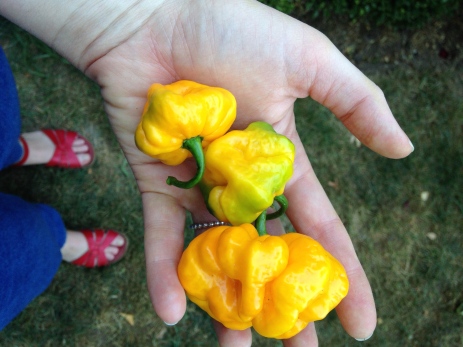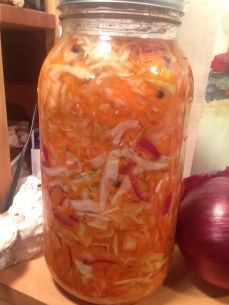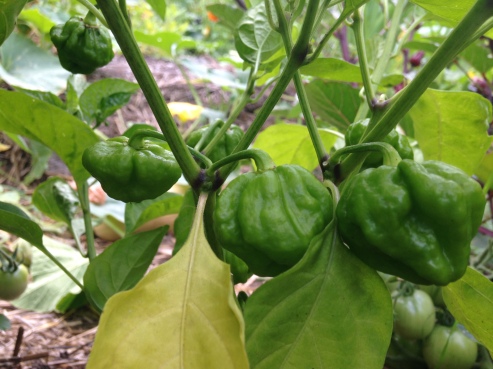Capsicum chinense: Jamaican Yellow Scotch Bonnet Pepper
Basics: Plant after danger of frost has passed, in full sun, 18-24″ apart. If starts are in coco fiber pots, be sure to gently tear the sides and bottom before placing in the soil, and if you choose, transplant with the pots into evenly leveled and watered soil. Water evenly throughout the season. Benefits from calcium, and a foliar spray of epsom salt solution when in flower. Peppers ready to harvest when green or bright yellow to orange. Seeds are extremely hot and will burn. Gloves are recommended when handling, but not necessary for harvest. Use milk in case of burning, as water will spread the capscacin.

Scotch Bonnet peppers from volunteer Bria Phillips’ garden (Bell & Star)
Scotch Bonnet peppers are the iconic hot pepper in Haitian cuisine, and popular throughout the Caribbean. In the habanero (Capsicum chinense) family of hot peppers, Scotch Bonnets are often cooked whole when either green or ripe. They are rarely eaten whole– often they are sliced thinly, with seeds removed. They have a unique fruity aroma, thin walls, and are a bright, cheery yellow. Scotch Bonnets grew very well in our plant trials in Oregon in 2014 and were the hands-down favorite of some of our volunteer gardeners.
A big reason to grow Scotch Bonnet peppers is to make the most delicious condiment in the world: pikliz. Keep reading for links to recipes and uses!
GROWING INFORMATION & USES:
Plant starts when all danger of frost is gone, just as you would other peppers, where they will get full sun all season long. Space 1-2 feet apart, and keep evenly watered. Water at the base of the plant, not the leaves, to avoid fungal diseases. However, like other peppers, Scotch Bonnets benefit greatly from a foliar spray of fish emulsion and epsom salts (1 Tbsp each per gallon of water) when flowering. Peppers ready for use when green, and ripe when yellow. BE VERY CAUTIOUS WITH THE SEEDS– they are extremely hot! Wear gloves when handling. Once you remove the seeds, parts of the flesh will not be too spicy, but where the seeds have touched will be extremely hot, and may even spice up the air.
A basic version of PIKLIZ, a condiment that is inseparable from the real flavor of Haitian cuisine. Pikliz (pronounced “pikleez”), a brightly colored, slightly fermented, vinegar-based slaw, is incredibly delicious. The fresh cabbage, carrots, and other seasonal vegetables, sliced very thinly with some kind of allium (such as red or yellow onion, shallots, or scallions, sometimes garlic), very little salt, some lime juice, black peppercorns, and cloves, all give pikliz its unique range of flavors- but it’s the Scotch Bonnet peppers that make the dish. We recommend using cane vinegar instead of regular white pickling vinegar- it is inexpensive and can easily be found in most Asian markets. Be sure to remove the seeds from the peppers when making pikliz, and wear gloves when handling the peppers.
Pikliz is integral to enjoying Haitian favorites like Acra (black eyed pea fritters– see the Southern Pea/Cowpea page) and Griot. Scroll down for more recipes.
Two more key Haitian flavorings:
Epis, a mixture of fresh flavors called for in many recipes, similar to sofrito, with native Taino and African roots.
Sauce Ti-Malice, or Sos Ti-Malis, from A Taste of Haiti cookbook, by Mirta Yunet-Thomas
This sauce is served warm, in a separate dish, for spooning over your meat, fish or rice dishes. It is also used as a condiment when cooking meat or fish dishes. I love it as a salad dressing.
1 to 2 tablespoons olive oil
1 onion, chopped
1 garlic clove, crushed and minced
2 shallots, finely chopped
1/4 green bell pepper, sliced thin
1/4 red bell pepper, sliced thin (optional)
2 tablespoons tomato paste
1/2 teaspoon salt, or to taste
1/4 teaspoon black pepper
2 to 3 tablespoons pikliz vinegar
juice of 1/2 lime (about 1 tablespoon)In saucepan, heat oil on medium heat. Add onion, garlic, and shallots and cook and stir for 2 minutes. Add peppers, tomato paste, salt, black pepper, pikliz vinegar, and lime juice, then cook and stir for 3 minutes. Add 2 cups water and bring to a boil. Cook for 15 minutes on low-medium heat. Let cool.
(another version of Sos Ti-Malis here, that includes fresh scotch bonnet peppers, instead of just the pikliz vinegar.)
HAITIAN RECIPES with Scotch Bonnet Peppers:
GRIOT, a defining dish of Haitian cuisine. Not your average fried pork. Residents of the Pacific Northwest can often find sour oranges in larger grocery stores in the winter, or at Caribbean markets. If you can’t find them, you can use limes. Best enjoyed with forks-full of pikliz (see above), and rinsed down with a big glass of Roselle.
An example of cooking with a whole Scotch Bonnet pepper, for later removal– here the pepper provides another depth of flavor and heat without stealing the show in this version of rice and beans, or Diri ak Pwa.
Saveur’s recipe for Poulet Creole, or Haitian Stewed Chicken— Scotch Bonnet pepper included.
Here is a version of Haitian Legumes, or stew. Legumes generally means some kind of vegetable dish, if you think of only the French word for vegetable, or the Latin root we use for beans, but in Haiti, beef is the central ingredient. Again, if you can’t find sour oranges, limes will do.
And now, wherever you see a call for “habanero pepper” in any Haitian recipe, you can use the authentic Scotch Bonnet peppers that you grow in your own garden!
Visit our photo album for more photos of Scotch Bonnet peppers and other plants we trialed in 2014 for the Grow Haiti! Collection.

